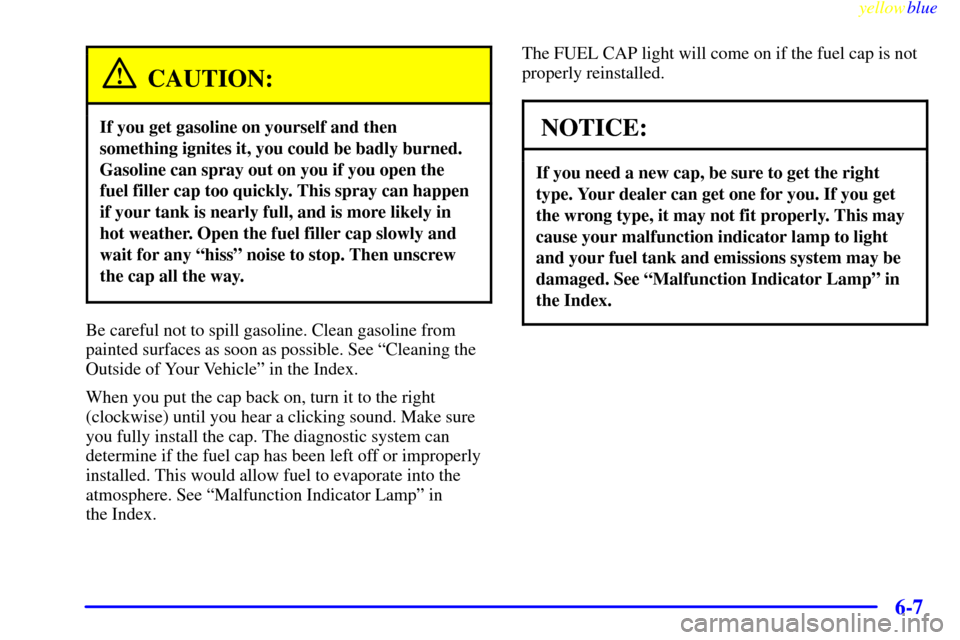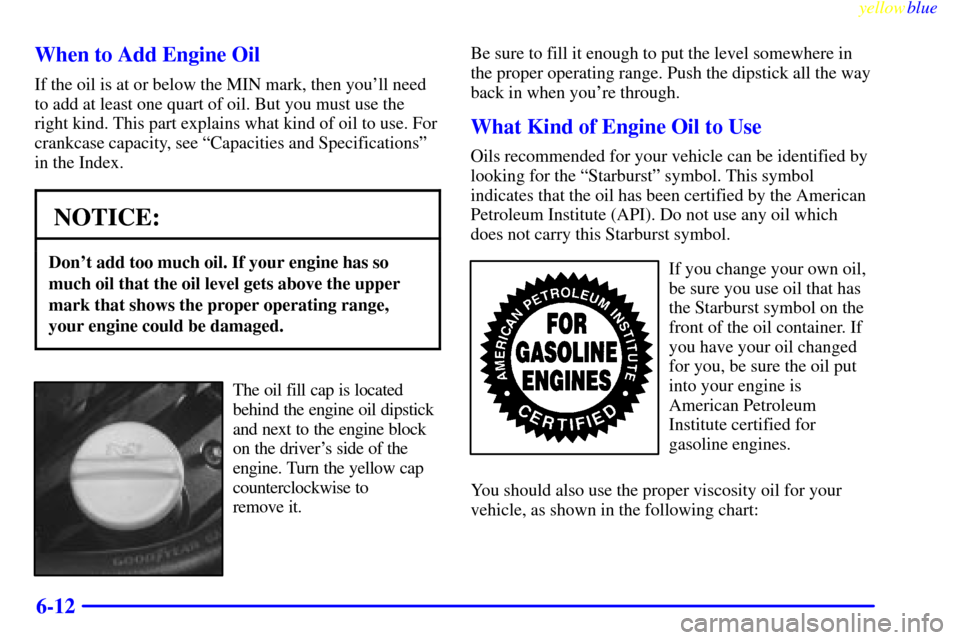Page 226 of 328
yellowblue
5-18
Changing a Flat Tire
If a tire goes flat, avoid further tire and wheel damage
by driving slowly to a level place. Turn on your hazard
warning flashers.
CAUTION:
Changing a tire can cause an injury. The vehicle
can slip off the jack and roll over you or other
people. You and they could be badly injured.
Find a level place to change your tire. To help
prevent the vehicle from moving:
1. Put the shift lever in PARK (P).
2. Set the parking brake firmly.
3. Turn off the engine.
To be even more certain the vehicle won't move,
you can put blocks at the front and rear of the
tire farthest away from the one being changed.
That would be the tire on the other side of the
vehicle, at the opposite end.
The following steps will tell you how to use the jack and
change a tire.
Page 228 of 328
yellowblue
5-20
The jack and tool kit are
located on the passenger's
side of the trunk. Pull the
red handle to remove the
cover and access
the equipment.
Turn the nut holding the jack counterclockwise and
remove it.
Page 230 of 328
yellowblue
5-22
2. Using the wheel wrench, loosen all of the wheel
bolts. Don't remove them yet.
3. Turn the jack handle clockwise to raise the jack lift
head 2 to 3 inches (5 to 7.6 cm).4. To access the jack hoisting notches, pull hard from
the back of the hoisting notch cover (located either in
front of or behind the tire you are changing).
Page 232 of 328
yellowblue
5-24
CAUTION:
Getting under a vehicle when it is jacked up is
dangerous. If the vehicle slips off the jack, you
could be badly injured or killed. Never get under
a vehicle when it is supported only by a jack.
CAUTION:
Raising your vehicle with the jack improperly
positioned can damage the vehicle and even make
the vehicle fall. To help avoid personal injury and
vehicle damage, be sure to fit the jack lift head
into the proper location before raising
the vehicle.6. Raise the vehicle by turning the jack handle
clockwise. Raise the vehicle far enough off the
ground for the spare tire to fit under the vehicle.
7. Remove all wheel bolts and take off the flat tire.
Page 234 of 328
yellowblue
5-26
11. Lower the vehicle by turning the jack handle
counterclockwise. Lower the jack completely. After
removing the jack, slide the jack hoisting notch
cover back in.
12. Tighten the wheel bolts
firmly in a crisscross
sequence as shown.
CAUTION:
Incorrect wheel bolts or improperly tightened
wheel bolts can cause the wheel to become loose
and even come off. This could lead to an accident.
Be sure to use the correct wheel bolts. If you have
to replace them, be sure to get new GM original
equipment wheel bolts.
Stop somewhere as soon as you can and have
the bolts tightened with a torque wrench to
80 lb
-ft (110 N´m).
Page 244 of 328
yellowblue
6-6
CAUTION:
Gasoline vapor is highly flammable. It burns
violently, and that can cause very bad injuries.
Don't smoke if you're near gasoline or refueling
your vehicle. Keep sparks, flames and smoking
materials away from gasoline.
To open your fuel door,
your vehicle must be in
PARK (P). Press the FUEL
DOOR unlock button
located on the instrument
panel center console to
unlock and open the
fuel door.
You can also press the fuel button on the remote keyless
entry transmitter to access the fuel cap.
Your vehicle has a tethered fuel cap.
To remove the cap, turn it slowly to the left
(counterclockwise). The cap has a spring in it; if you let
go of the cap too soon, it will spring back to the right.
Page 245 of 328

yellowblue
6-7
CAUTION:
If you get gasoline on yourself and then
something ignites it, you could be badly burned.
Gasoline can spray out on you if you open the
fuel filler cap too quickly. This spray can happen
if your tank is nearly full, and is more likely in
hot weather. Open the fuel filler cap slowly and
wait for any ªhissº noise to stop. Then unscrew
the cap all the way.
Be careful not to spill gasoline. Clean gasoline from
painted surfaces as soon as possible. See ªCleaning the
Outside of Your Vehicleº in the Index.
When you put the cap back on, turn it to the right
(clockwise) until you hear a clicking sound. Make sure
you fully install the cap. The diagnostic system can
determine if the fuel cap has been left off or improperly
installed. This would allow fuel to evaporate into the
atmosphere. See ªMalfunction Indicator Lampº in
the Index.The FUEL CAP light will come on if the fuel cap is not
properly reinstalled.
NOTICE:
If you need a new cap, be sure to get the right
type. Your dealer can get one for you. If you get
the wrong type, it may not fit properly. This may
cause your malfunction indicator lamp to light
and your fuel tank and emissions system may be
damaged. See ªMalfunction Indicator Lampº in
the Index.
Page 250 of 328

yellowblue
6-12 When to Add Engine Oil
If the oil is at or below the MIN mark, then you'll need
to add at least one quart of oil. But you must use the
right kind. This part explains what kind of oil to use. For
crankcase capacity, see ªCapacities and Specificationsº
in the Index.
NOTICE:
Don't add too much oil. If your engine has so
much oil that the oil level gets above the upper
mark that shows the proper operating range,
your engine could be damaged.
The oil fill cap is located
behind the engine oil dipstick
and next to the engine block
on the driver's side of the
engine. Turn the yellow cap
counterclockwise to
remove it.Be sure to fill it enough to put the level somewhere in
the proper operating range. Push the dipstick all the way
back in when you're through.
What Kind of Engine Oil to Use
Oils recommended for your vehicle can be identified by
looking for the ªStarburstº symbol. This symbol
indicates that the oil has been certified by the American
Petroleum Institute (API). Do not use any oil which
does not carry this Starburst symbol.
If you change your own oil,
be sure you use oil that has
the Starburst symbol on the
front of the oil container. If
you have your oil changed
for you, be sure the oil put
into your engine is
American Petroleum
Institute certified for
gasoline engines.
You should also use the proper viscosity oil for your
vehicle, as shown in the following chart: